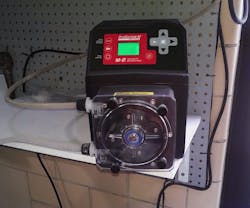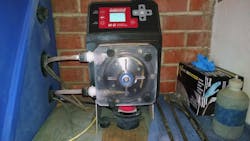Application:
The Bellevue Water Treatment Plant, located in Bellevue, Ohio, serves approximately 3,500 customers and operates an average of 16 hours per day. The plant treats surface water from four reservoirs and two separate water locations. The amount of water being treated typically falls in the range of 1.8 million gallons during summer, declining to approximately 1.2 million gallons during winter.
The Bellevue Plant’s four reservoirs can store a billion gallons of water. In order to meet or exceed the exacting requirements set by the EPA, the treatment process uses a variety of chemical, including:: potassium permanganate to treat for organics and algae, ferric chloride to coagulate and settle particle, lime to soften and treat for organics, sodium hydroxide to soften and lower the noncarbonated hardness, powder activate carbon to control taste and odors, liquid CO2 to lower the pH, phosphate for corrosion control for the distribution system, chlorine for disinfection, and fluoride for dental protection (as mandated by the state).
Problem:
The Bellevue Water Treatment Plant originally installed costly peristaltic metering pumps to inject the many chemicals used to treat the raw water. Although these pumps were performing satisfactorily, they required frequent maintenance and expensive parts replacement, resulting in increased costs and downtime. In addition, tubing was especially difficult to order due to problems locating sales representatives, long lead times, and high prices.
Solution:
The Water Treatment Plant slowly began to replace the peristaltic chemical pumps they were using, with the Blue-White® Industries’ Proseries-M® line of Flex-Pro® peristaltic metering pumps.
The switch began with the purchase of a Flex-Pro® M-3 metering pump to feed the lime cure. Following the success of the M-3 in that application, two additional M-3 pumps were acquired, one to pump potassium permanganate and one to pump fluoride.
With the ongoing success of Flex-Pro® M-3 pumps in the treatment process, Bellevue Water Treatment Plant ordered a CHEM-FEED® double skid system. This fully equipped skid system featured a simple drop in place design and was fitted with two Flex-Pro M-3 metering pumps. These are being used to inject sodium hydroxide.
Recently the Treatment Plant had a carbon building upgrade. This resulted in three of the higher capacity FLEX-PRO® M-4 peristaltic metering pumps being installed which are being assessed.
Results:
Blue-White’s® ProSeries-M® M-3 and M-4 chemical feed pumps, as well as the CHEM-FEED® complete double skid system, were successful in assuring Bellevue is able to efficiently and successfully meet the high standard of proper water treatment.
In addition, the chemical feed pumps were simple to order, well-priced, energy efficient and reduced plant and operator downtime.
Replacement parts have been easy to find and to order, and lead times are reasonable. The pump head tubes have an increased tube life and are fast and simple to replace. Bellevue Water Treatment has reported saving money on both energy costs and maintenance expense with Flex-Pro®.
The success of Flex-Pro M series pumps in the installation has resulted in the decision by Bellevue Water Treatment Plant to begin replacing all the originally installed pumps with Blue-White® chemical feed pumps.
Editor's Note: Scranton Gillette Communications and the SGC Water Group are not liable for the accuracy, efficacy and validity of the claims made in this piece. The views expressed in this content do not reflect the position of the editorial teams of Water & Wastes Digest, Water Quality Products and Storm Water Solutions.

